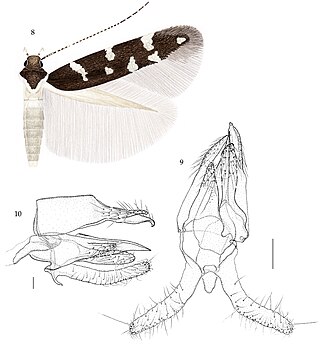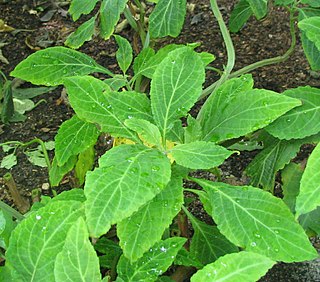
Salvia officinalis, the common sage or sage, is a perennial, evergreen subshrub, with woody stems, grayish leaves, and blue to purplish flowers. It is a member of the mint family Lamiaceae and native to the Mediterranean region, though it has been naturalized in many places throughout the world. It has a long history of medicinal and culinary use, and in modern times it has been used as an ornamental garden plant. The common name "sage" is also used for closely related species and cultivars.
The Cosmopterigidae are a family of insects in the order Lepidoptera. These are small moths with narrow wings whose tiny larvae feed internally on the leaves, seeds and stems of their host plants. About 1500 species are described. The taxonomic family is most diverse in the Australian and Pacific region with about 780 species.

Vulcaniella kabulensis is a moth of the family Cosmopterigidae. It is endemic to Afghanistan.

Salvia divinorum is a species of plant in the sage genus Salvia, known for its transient psychoactive properties when its leaves, or extracts made from the leaves, are administered by smoking, chewing, or drinking. The leaves contain the potent compound salvinorin A and can induce a dissociative state and hallucinations.

Vulcaniella is a genus of moths in the family Cosmopterigidae, containing the following species:
Vulcaniella cognatella is a moth of the family Cosmopterigidae. It is found from Ukraine to Sardinia and Greece.
Vulcaniella fiordalisa is a moth of the family Cosmopterigidae. It is found from Portugal and Morocco, east to the Balkan Peninsula and Lebanon.
Vulcaniella gielisi is a moth of the family Cosmopterigidae. It is found in Spain.
Vulcaniella anatolica is a moth of the family Cosmopterigidae that is endemic to Turkey.
Vulcaniella pontica is a moth of the family Cosmopterigidae that is endemic to Turkey.
Vulcaniella grabowiella is a moth of the family Cosmopterigidae. It is found from the Iberian Peninsula to Asia Minor.
Vulcaniella karadaghella is a moth of the family Cosmopterigidae. It is found in Asia Minor and on the Crimea.
Vulcaniella klimeschi is a moth of the family Cosmopterigidae. It can be found in Macedonia, mainland Greece and Crete.
Vulcaniella pomposella is a moth of the family Cosmopterigidae. It is found from France, the Baltic Region and Ukraine to the Mediterranean region.
Vulcaniella rosmarinella is a moth of the family Cosmopterigidae. It is found in the area surrounding the Mediterranean Sea, as far east as Crete. It is also found in North Africa.
Vulcaniella grandiferella is a moth of the family Cosmopterigidae. It is found in Serbia, Macedonia, Greece, Ukraine and southern Russia.
Vulcaniella glaseri is a moth in the family Cosmopterigidae. It was described by Riedl in 1966. It is found in Turkey.
Ramphis libanoticus is a moth in the family Cosmopterigidae. It is found in Greece, Crete, Cyprus and Asia Minor.
Vulcaniella caucasica is a moth of the family Cosmopterigidae. It is found in Asia Minor, the Caucasus, Armenia and Azerbaijan.
Vulcaniella vartianae is a moth in the family Cosmopterigidae. It was described by Hans Georg Amsel in 1968 and is found in Pakistan.


